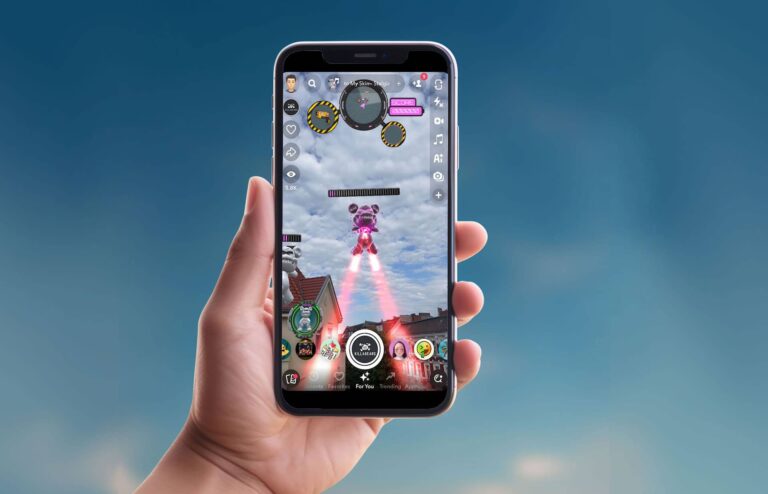
Killabears is back with more AR. Following its Snapchat lens campaign that we profiled in January, it’s now out with an AR game that flips the perspective to the rear-facing camera. It fills players’ space with attacking Killabears they can shoot down to stay alive and gain points.
This makes it a sort of cross between a first-person wave shooter and Plants vs. Zombies. It carries the latter’s vibes in the fast-paced action to mow down assailing Killabears before they close in on you. And the dimensionality makes it all the more immersive and heart-pounding.
That includes a 360 gamescape where Killabears spawn through portals (see video below). This makes it an active endeavor of rapidly spinning around in your chair (or standing) to fend off attackers from all angles. And the whole thing is gamified through a real-time leaderboard.
Altogether, the game represents a key trend with Snapchat Lenses: They’re evolving to levels of interactivity and dimension once only seen in full-blown apps. In other words, we’ve come a long way since dog ears and rainbow vomit… creators are getting quite creative with Lens Studio.
Native Territory
Another notable component is an In-Lens Digital Goods system for weapons that can be earned through gameplay or purchased to fast-track a player’s advancement. This taps into semi-new functionality from Snap to help creators monetize lenses through player transactions.
Moreover, this model is conducive to Killabears because – as we noted in Part 1 – digital transactions are native territory given that it’s primarily a digital collectible. In fact, Killabears could go where only one AR experience has substantially made it with in-app purchases: Pokémon Go.
Further brand alignment comes in the gameplay itself. Like the first campaign, the game captures the ethos of Killabears by animating them in signature ways. That ethos is a sort of dark humor spin on homicidal plush-character collectibles with independent comic stylings.
In fact, the game captures those vibes to even greater degrees than the first lens campaign because Killabears are actually trying to kill you, experienced from a first-person perspective. This immerses Killabears enthusiasts in a companion experience to the core collecting activity.
Doubling Down
Stepping back, you could say we saw this coming, given Killabears’ co-founder & CEO Ben Cohen’s excitement in the first campaign. We could hear the eagerness in his voice to double down on the AR action to animate and bring depth to his creations. Or as we wrote at the time:
In the meantime, AR lenses align with another principle in Cohen’s playbook which is to make digital collectibles approachable. He admits that most of the Web 3 and NFT worlds– where Killabears very much resides – have been too intimidating and complex for broader audiences.
So his goal is to build a bridge from Web 2 to Web 3. This can be seen in the brand itself, including the playful nature of the IP, and other moves the company has made to market it. Lens-ifying the brand was just the latest play in that playbook, and we can likely expect more.
The rest is history, including working with the same team of partners at M7 Innovations and QReal. Like the first campaign, M7 quarterbacked the media strategy and overall direction while QReal applied its best-of-breed 3D and AR design chops to bring the plush characters to life.
Something tells us we can still expect more from this trio in terms of interactivity and augmentation in the Killaverse. In fact – spoiler alert – M7 Innovation’s Matt Maher tells AR Insider that the game could one day jump from handheld to headworn… perhaps coming to a Quest 3 near you.






